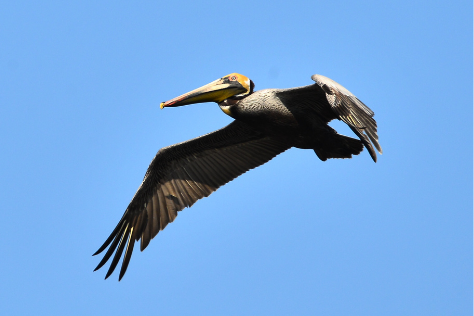
Discover the Birds of Ponce Inlet
Birds are abundant in Ponce Inlet. Why does Ponce Inlet attract so many birds? Ponce is surrounded by water on three sides. These bodies of water include the Atlantic Ocean to the east, Ponce Inlet to the south, and the Halifax River to the west. These water sources provide an abundance of food and ample nesting opportunities for a wide range of coastal bird species including plovers, hawks, sea gulls, egrets and sandpipers to name just a few. Ponce Inlet is truly a bird watching paradise!
Take a stroll down the beach or along Ponce Preserve’s ¼ mile long boardwalk that meanders through the salt marsh and count how many bird species you see. Keep an eye out for the Piping Plover along the shoreline as it scurries about the white sands of the beach. The Piping Plover is a state and federally protected species of bird found in Ponce where it winters. Witness a Brown Pelican glide gracefully over the Atlantic Ocean in search of a fish and watch in amazement as it dives headfirst into the surf in pursuit of its next meal. Photograph a great blue heron or snowy egret as it wades among the mangroves and stands majestically in the shallow marsh grass as if waiting for you to snap a picture.
Plover
Visit the Ponce Preserve to see Birds in the Wetlands to the Seashore
Nestled between the Halifax River and Atlantic Ocean, Ponce Preserve stretches across the entire width of the peninsula. This unique town park includes a ¼ long elevated boardwalk that extends out into the Halifax River and numerous nature walks winding through the large hardwood coastal hammock Visitors to the beautiful setting will enjoy numerous opportunities to view wildlife including many species of birds. A leisurely stroll might include an encounter with Anhinga, Ducks, Heron, and Egrets. An Osprey may even be seen flying overhead with a freshly caught fish in its beak. Ponce Preserve is included in the East Section of the Great Florida Birding Trail.
Osprey
The neighborhoods of Ponce often attract various Blackbirds, Cardinals, Jays, Mourning Doves and Woodpeckers. There are retaining ponds which attract White Ibis and the rare and protected Wood Stork. Varieties of predatory birds can be seen here. You might see a Red-tailed Hawk. There are Black and Turkey Vultures which tend to winter in Ponce. These creepy creatures provide a community service by devouring dead mammals, reptiles and fish.
Depending on the time of year you visit, you may see different migratory bird species. The warmer winters that Florida offers creates the perfect environment for birds escaping the northern cold.
Woodstork
What Can You Do to Protect the Ponce Inlet Birds?
You can help our resident and visiting birds by cleaning up trash and recycling disposable plastics. Did you know that monofilament fishing line takes over 500 years to decompose? Birds can become entangled in it and die. There are fishing line recycling receptacles all along the Ponce Inlet Jetty walkway.
Do not disturb birds in their natural habitat. Avoid touching or moving nests or eggs. Keep a respectable distance as to not cause birds to feel threatened by your presence. Bring you binoculars to get a closer look!
Don’t feed wild birds as it may cause aggressive behavior and human food often makes them sick. If you find an injured bird, report it to local officials like park staff or lifeguards. You can always contact the Florida Fish and Wildlife Commission at 1-888-404-FWCC (3922).
Ponce is home to The Mary Keller Seabird Rehabilitation Sanctuary
The Marine Science Center in Ponce Inlet boasts The Mary Keller Seabird Rehabilitation Sanctuary. It is a fully functional animal hospital which has treated over 18,000 birds from 200 different species.
The injured bird drop-off area is opposite the marina, by the boat trailer parking lot at 4965 S. Peninsula Drive. It is open for rehabilitation seven days a week, from 8 a.m. to 4:30 p.m. After hours, call 386-561-0624. The MSC has been mostly closed to the public during Covid-19.
Visit the Ponce Inlet Lighthouse and Museum
Visit our Lighthouse to get a “bird’s eye view” of Ponce Inlet. You will see the surrounding landscape and waterways. Visit the intriguing exhibits throughout the museum grounds. Experience what life was like for a Lighthouse keeper and his family during the early days. Witness black and white footage of the beginning of car and motorcycle racing on the beach. Don’t miss our grand lens exhibit.
Spend time browsing our gift shop to find that perfect souvenir. Pick up a book about the birds of Florida while you are there. Climb the 203 steps up the black, spiral staircase to the top. Step out on the deck to take in the amazing views. Experience a bird’s eye view of beautiful Ponce Inlet.
We’re taking COVID-19 precautions. Click here to earn more about how we’re working hard to keep you safe!
----------------------------------------------------------------------------------------
Sources
Alden, Peter, et al. National Audubon Society Field Guide to Florida. Knopf, 2019.
aab_admin_user. “Online Bird Guide, Bird ID Help, Life History, Bird Sounds from Cornell.” All About Birds, 17 Mar. 2021, 1:00PM, www.allaboutbirds.org/.
“Birding in Daytona Beach.” Daytona Beach Birding | Ecotourism, Nature, Mar. 2021, 12:00PM, www.daytonabeach.com/things-to-do/outdoors/birding/.
“Halifax River Audubon.” Halifax River Audubon Society, 17 Mar. 2021, 2:00PM, www.halifaxriveras.org/.
Www.volusia.org , 17 Mar. 2021, 12:30, www.volusia.org/services/growth-and-resource-management/environmental-management/natural-resources/birding-guide.stml.